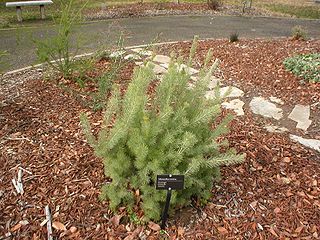Woollybush, woolly bush or woolly-bush is a common name for plants of the genus Adenanthos with leaves deeply divided into long, soft, slender laciniae, often covered in a fine down of soft hairs. These properties give the leaves a soft, silky feel, in stark contrast to the sclerophyllous plants that dominate both its geographic range (southern Australia) and its taxonomic family (Proteaceae). This softness accounts for the common name. [1]

Adenanthos is a genus of Australian native shrubs in the flowering plant family Proteaceae. Variable in habit and leaf shape, it is the only genus in the family where solitary flowers are the norm. It was discovered in 1791, and formally published by Jacques Labillardière in 1805. The type species is Adenanthos cuneatus, and 33 species are recognised. The genus is placed in subfamily Proteoideae, and is held to be most closely related to several South African genera.

Sclerophyll is a type of vegetation that has hard leaves, short internodes and leaf orientation parallel or oblique to direct sunlight. The word comes from the Greek sklēros (hard) and phyllon (leaf).

Australia, officially the Commonwealth of Australia, is a sovereign country comprising the mainland of the Australian continent, the island of Tasmania, and numerous smaller islands. It is the largest country in Oceania and the world's sixth-largest country by total area. The neighbouring countries are Papua New Guinea, Indonesia, and East Timor to the north; the Solomon Islands and Vanuatu to the north-east; and New Zealand to the south-east. The population of 25 million is highly urbanised and heavily concentrated on the eastern seaboard. Australia's capital is Canberra, and its largest city is Sydney. The country's other major metropolitan areas are Melbourne, Brisbane, Perth, and Adelaide.
13 species of Adenanthos possess these properties. [1] Many of these have common names that include the woollybush epithet. However the two species of Adenanthos that occur outside Western Australia are both woollybushes yet have common names based on the name gland flower. This suggests that the common name woollybush is exclusively a Western Australian name. [2]
Species of woollybush include:
- Adenanthos acanthophyllus (prickly woollybush)
- Adenanthos argyreus (little woollybush)
- Adenanthos cygnorum (woollybush, common woollybush)
- Adenanthos dobagii (Fitzgerald woollybush)
- Adenanthos labillardierei
- Adenanthos macropodianus (Kangaroo Island gland flower)
- Adenanthos meisneri (prostrate woollybush)
- Adenanthos oreophilus (woollybush)
- Adenanthos sericeus (woollybush, coastal woollybush, tall woollybush, Albany woollybush)
- Adenanthos terminalis (yellow gland flower)
- Adenanthos velutinus (velvet woollybush)
- Adenanthos × cunninghamii (woollybush, Albany woollybush, prostrate woollybush)
Adenanthos acanthophyllus, commonly known as prickly woollybush, is a species of shrub endemic to Western Australia.
Adenanthos argyreus, commonly known as little woollybush, is a species of erect shrub endemic to southwest Western Australia.

Adenanthos cygnorum, commonly known as common woollybush or just woollybush, is a tall shrub in the family Proteaceae. It is endemic to Western Australia, commonly occurring in the south west of the State from north of Geraldton south to Kojonup. It is very common on road verges and in disturbed areas of Perth.
Ernest Charles Nelson states that the name has been in use for a long time, and believes that it originated in the vicinity of Albany, Western Australia. [2]
(Ernest) Charles Nelson is a botanist who specialises in the heather family, Ericaceae, especially Erica, and whose past research interests included the Proteaceae especially Adenanthos. He is the author or editor of over 24 books and more than 150 research papers. He was honorary editor of Archives of Natural History between 1999 and 2012, and was honorary editor of Heathers for 23 years until 2017.

Albany is a port city in the Great Southern region in the Australian state of Western Australia, 418 km southeast of Perth, the state capital. Albany is the oldest colonial settlement in Western Australia, predating Perth and Fremantle by over two years.












